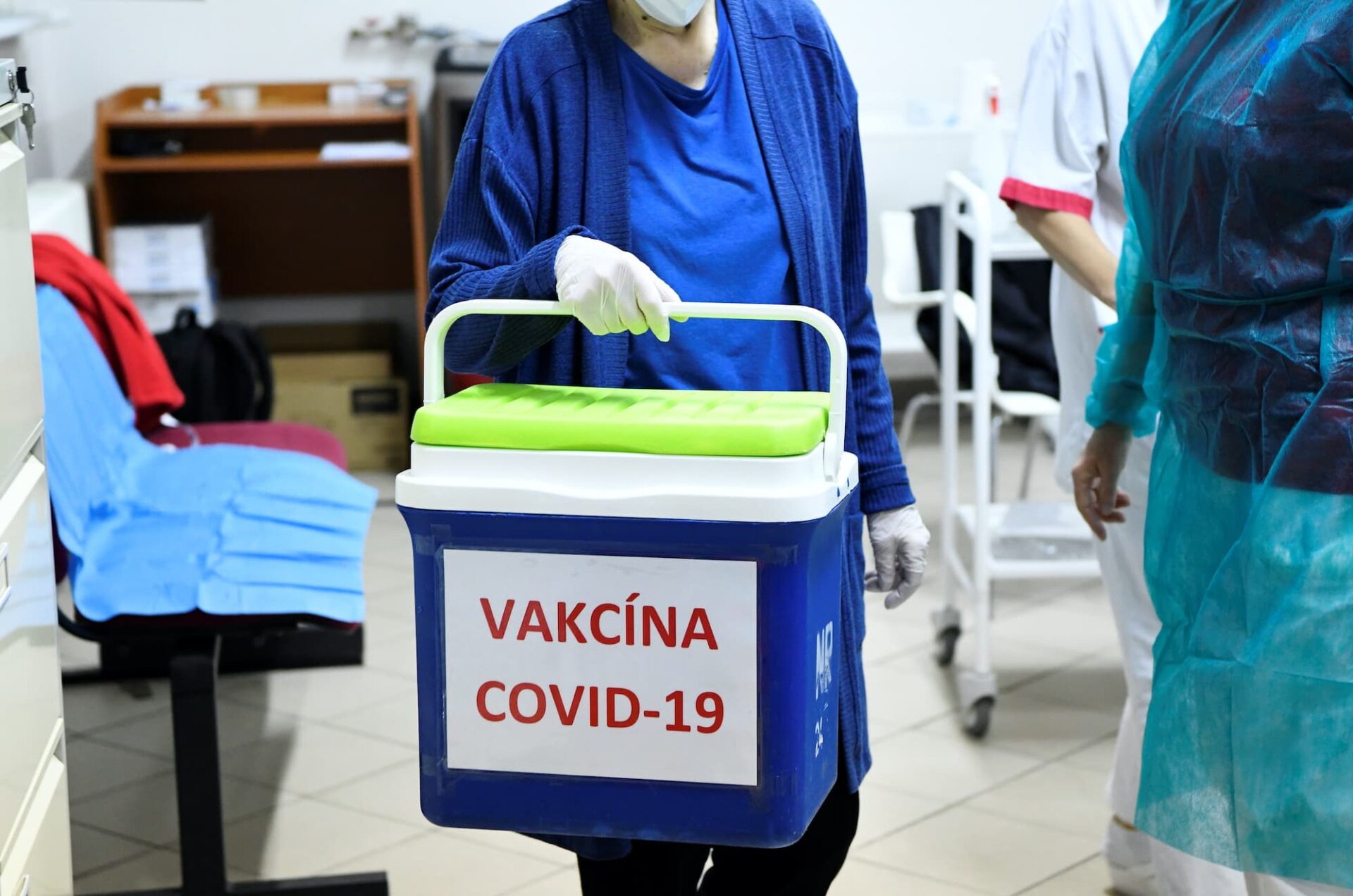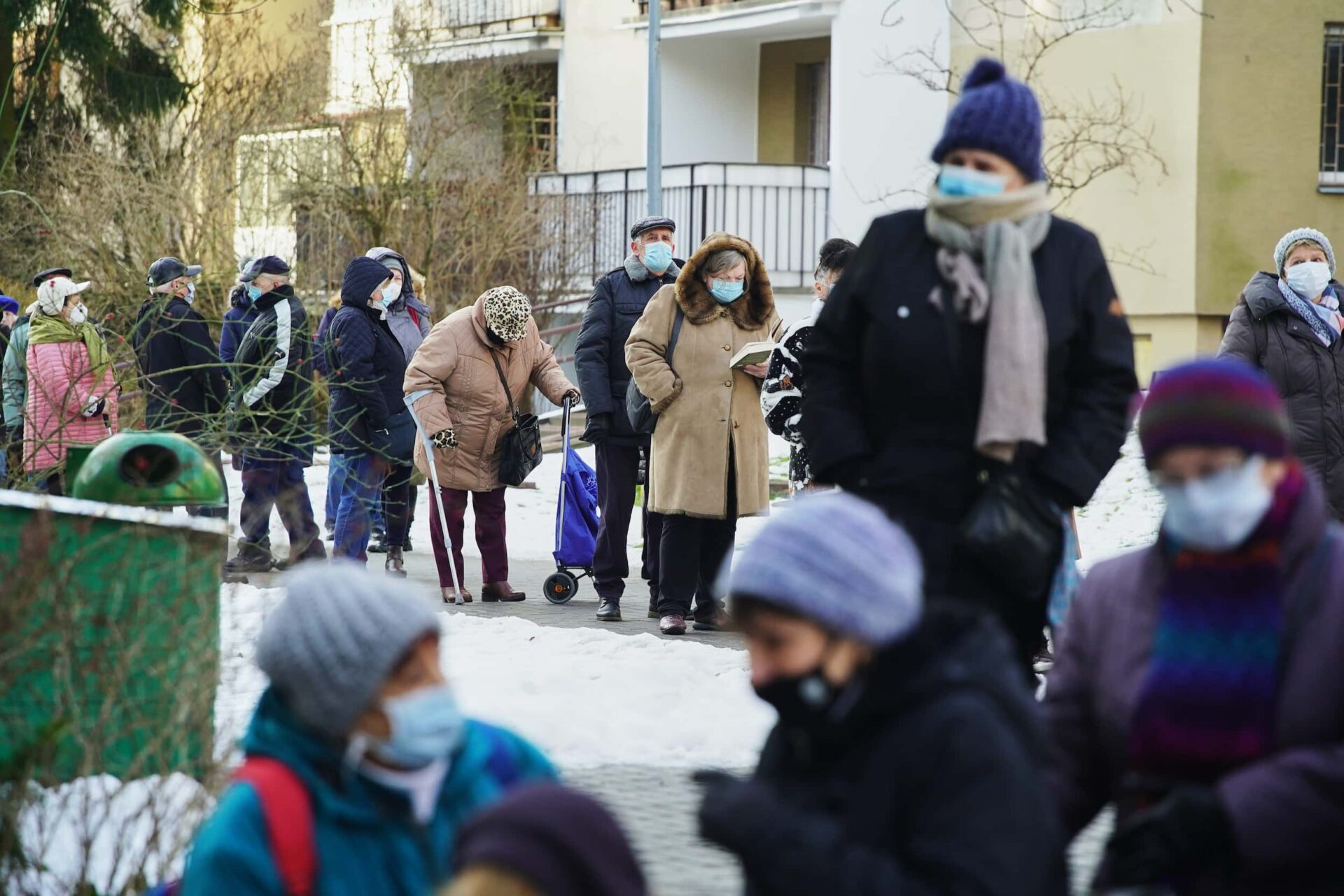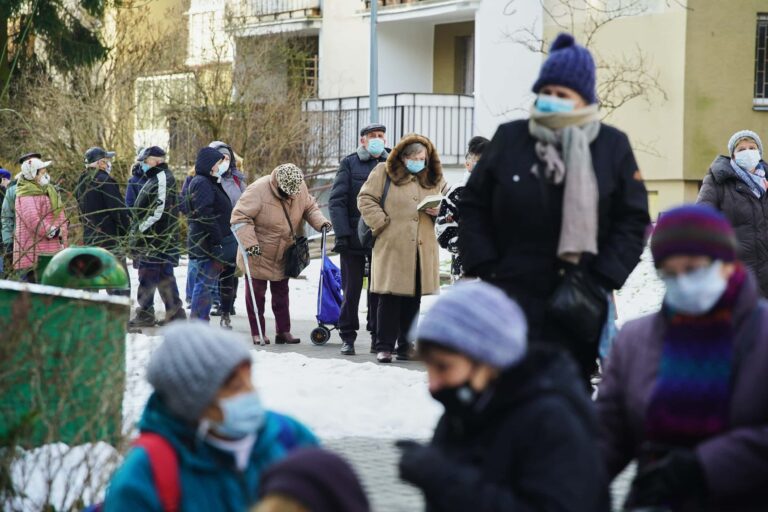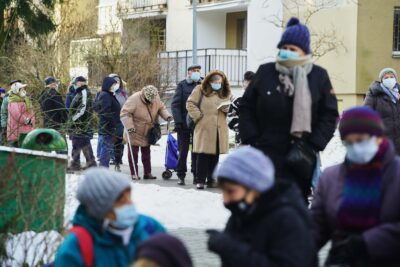Too few vaccines, not enough personnel, poor organisation, chaos, and growing disinformation campaigns – all four countries of the Visegrad Group (V4) are struggling with their vaccination programmes. But they share something else in common: scandals revolving around the privileged skipping the line.
On Saturday, 26 December 2020, in front of live-television cameras, Vladimír Krčméry, a well-known doctor and epidemiologist, became the first Slovak to receive a COVID-19 vaccine. Between then and Monday, 18 January 2021, Slovakia administered 71,400 doses of the vaccine (each person must receive two shots. We were not able to access a breakdown of how many of these doses were the first jab and how many were the second).
This averages out to 2,975 doses per day. According to the Vaccination Strategy of the Ministry of Health, which is responsible for the vaccination programme in Slovakia, the country needs to vaccinate at the very least 3.3 million people (out of the total population of 5.5 million) to achieve herd immunity. This equates to 6.6 million doses. If vaccination centres were able to deliver on average 3,000 injections per day, it would take six years to meet this goal. Although the programme got off to a slow start, the pace has been gradually picking up, as more and more vaccination centres open. On 18 January, 11,321 doses of the vaccine were administered. But even at this rate, it would still take around 1.5 years to vaccinate the lowest estimate needed to achieve herd immunity.
According to the ministry’s strategy, during the first stages of the programme, 25 vaccination centres were supposed to be up and running, out of an eventual total of 79 – one in each county. On 18 January, 41 of them were open.
In the meantime, Slovak Prime Minister Igor Matovič has called for testing the entire population once again, which was successfully done in the autumn. Critics of this idea argue that resources could be better spent on the vaccination programme as mass testing would require the mobilization of thousands of medical workers, as Slovakia learned in the autumn.
The rollout plan for the vaccine originally had four phases. However, the government revised the plan and announced a new one, with eleven phases. The medical workers are still in the first phase, followed now by all people over 85, 75 and 65 years which will be vaccinated in the second, third and fourth phase. After them, people with serious illnesses are in phase five and people with less serious illnesses in phase six, including i.e. obese people with BMI over 30. After them, teachers over 55 follow in seventh phase, all other people over 55 in eight, the rest of teachers of ninth and all the rest of the citizens over 45 in tenth phase. Only in the final eleventh phase all the other adult citizens shall be vaccinated.
Notably, people working in the critical infrastructure of the state have been left out of the new vaccination plan, even though originally they were in the very first group. Now, these people can fill in into the “reserves” lists, and shall there be any thawed vaccines left at the end of the day, these people will be offered a chance to get their jabs.
In Hungary, as in Slovakia, the vaccination campaign was launched on 26 December 2020, with healthcare professionals first receiving injections. So far, there are 25 hospitals functioning as vaccination centres, and on 7 January, inoculation began in the country’s four largest elderly care facilities. By 14 January, approximately 105,700 people had received their first dose of the vaccine.
The Hungarian vaccination plan is based on recommendations made by the National Public Health Centre, which has divided the population into seven major groups. Healthcare professionals, residents and employees of elderly care homes, and people over the age of 60 are the first in line. The next group consists of members of law enforcement working on the frontlines of the epidemic, followed by people aged 18-59 with chronic illnesses and critical infrastructure workers who are at great risk of being exposed to the virus. The last group comprises the general public.
In Poland, the first person to be vaccinated, also in front of television cameras, was Alicja Jakubowska, a nurse from the MSWiA hospital in Warsaw, on 27 December 2020. After the procedure, Jakubowska asked journalists: “Can you see the happiness in my eyes?” Three weeks later, however, Poland was still months away from its goal of developing herd immunity and ending the pandemic. According to the government, the country is technically prepared to vaccinate around 200,000 people per week at over 5,000 clinics. Whether this will happen remains to be seen. At the time of writing, 469,466 people have already received the first dose of the vaccine. The daily average slightly exceeds 11,000.
Phase 0 of the Polish vaccination programme – intended almost exclusively for medical professionals – has not yet finished. Only 36 percent of healthcare workers have been vaccinated, and another 45 percent have already registered for their shots. In contrast to most European countries, in Poland, Group 0 does not include nursing home or hospice residents. Despite the deadly toll that the pandemic has already taken on this particular group, they only began receiving vaccinations on 15 January, as part of Group 1 along with teachers, lecturers, first responders (e.g., soldiers, firefighters, police), the chronically ill, and seniors citizens (60+). On 14 January a plan was unexpectedly announced to expand this priority group to include prosecutors and the staff of the Central Anti-Corruption Bureau. This idea was widely criticized, even by Professor Andrzej Horban, a national consultant on infectious diseases.
In the Czech Republic, like in Poland, the first vaccines were administered on Sunday, 27 December 2020. Almost a thousand doses provided by Pfizer-BioNTech were given to healthcare professionals working in hospitals. Andrej Babiš, the Czech prime minister, was also among the very first people vaccinated against coronavirus.
In the first two months, around 350,000 people should be vaccinated. The Czech Republic has marked hospital workers and people in retirement homes as the most crucial group. First responders, such as firefighters, soldiers helping with the COVID-19 pandemic, police officers, and ambulance workers, will also have priority.
A scramble for vaccines
The most commonly cited explanation for the slow pace of vaccination rollout in the V4 countries is insufficient supply. For example, Poland almost exclusively administers the Pfizer vaccine, as the country has received only one shipment of 29,000 vaccines from Moderna so far. In total, Poland ordered 62 million doses from five companies, which should be enough to vaccinate every adult in the country in 2021. Over half will be supplied by AstraZeneca and Johnson & Johnson, whose vaccines have still not been approved by the EU.
This lack of materials has hampered the entire process. On top of that, Poland decided to split the deliveries in half, saving the second dose to be administered 21 days after the first. This strategy was strongly criticized. Other countries (e.g., Denmark) prefer to vaccinate as many people as possible with a first dose even at the risk of postponing the second one. Right now though it seems as if this precaution was worth taking as Pfizer has announced plans to reduce deliveries to Europe for several weeks. The change was abrupt — the last delivery from Pfizer contained only half of the planned doses. As a result, Michał Dworczyk, Chief of the Chancellery, decided to postpone vaccinating 330,000 hospital employees.
As part of the joint EU procurement agreement, Hungary has received 19 million doses of the vaccine so far, enough to inoculate 8 million people. According to government plans, 3.3 million of them will get the Pfizer vaccine, and 872,000, the Moderna jab. Hungary has also reserved AstraZeneca and Johnson & Johnson vaccines, supplies for 3.27 million and 2.1 million people, respectively.
Recently, an agreement was signed with the Chinese producer of the Sinopharm vaccine. If the Hungarian authorities approve the vaccine, a first shipment of approximately 1 million doses could soon be on the way. However, there are some questions about this vaccine, particularly in light of the information provided by the manufacturer that further testing is needed to determine whether the vaccine can be safely administered to the elderly.
A few days ago Hungary became the first country in the EU to give preliminary approval to the AstraZeneca and Sputnik V vaccine. The Russian vaccine would be sufficient for 1 million people. However, there are particularly strong feelings in the general public about the prospect of non-EU developed vaccines. Some polls suggest that only seven percent of Hungarians would accept the Russian vaccine, and the acceptance of the Chinese version is even lower.

A healthcare worker carries the Pfizer-BioNTech COVID-19 vaccine at the University Hospital in Nitra, Slovakia, 26 December, 2020. Source: RADOVAN STOKLASA / Reuters / Forum
In Slovakia the only vaccine to have been administered so far is Pfizer-BioNTech’s Comirnaty, but a 5,000-dose first batch of Moderna’s vaccine has already arrived. Altogether, 133,500 doses have been delivered to Slovakia so far, but most are waiting in warehouses.
Based on current orders, until the end of January, Slovakia should receive a cumulative total of between 208,000 and 250,000 doses (including those that were already delivered). If, as planned, all 79 vaccination centres give 500 injections per day, the supply would be gone in six days.
But all 79 centres are not operating, and those that have opened are not vaccinating at the planned speed yet. So, these supplies should last well into February unless Pfizer delivers much fewer doses than planned as a result of the aforementioned Europe-wide delivery limitations. The short-supply argument, therefore, doesn’t fully hold water.
One possible problem might be that EU approval of the Oxford/AstraZeneca vaccine seems to be under threat due to unfavourable study results, stated Slovak health minister Marek Krajčí on Friday, 15 January, adding that this could pose a “huge threat” to the Slovak vaccination effort. Studies conducted in Australia show this vaccine is only 62 percent effective in preventing COVID-19, which might not be enough to generate herd immunity, the Sydney Morning Herald reports.
The two currently available vaccines, produced by Pfizer-BioNTech and Moderna, are mRNA vaccines that must be stored at extremely low temperatures (-20 to -80 degrees Celsius), complicating logistics and slowing down Slovakia’s vaccination programme. The Oxford/AstraZeneca vaccine, on the other hand, is a more typical viral vector-based product that can be stored at temperatures between 2 and 8 degrees Celsius. Approval would speed up the programme, and the Slovak strategy is counting on it to a large degree.
Altogether, Slovakia has ordered, via the European Commission, over 3.3 million mRNA vaccines (2.4 million from Pfizer/BioNTech and 962,000 from Moderna), and over 6 million doses of vector-based vaccines, more than 3.6 million from Oxford/AstraZeneca, the first of which were expected to arrive by the end of January, and the rest (2.4 million) from Johnson & Johnson. The latter, however, are not expected to arrive sooner than Q2 2021. On top of that, PM Matovič announced that on Monday, January 18., Slovakia ordered additional 4 million doses from Pfizer/BioNTech and Moderna via the EU scheme and therefore shall have enough doses to vaccinate 85 percent of the adult population.
The Czech Republic has prepaid for vaccines produced by five major pharmaceutical companies — Pfizer/BioNTech, Moderna, AstraZeneca, Curevac, and Johnson & Johnson – according to the COVID-19 Vaccination Strategy, published a few days before Christmas. In total, almost 12 million vaccines for nearly 7 million people have been purchased (as we mentioned earlier, some of the vaccines need to have two doses per person). “The Czech Republic is currently not considering expanding its product portfolio beyond existing agreements,” notes the strategy.
The Czech daily Deník N reports that the Czech Republic had the opportunity to buy more vaccination doses but did not. Deník N’s source confirmed that the European Commission did not set a limit on the number of doses for each Member State. In comparison, Germany ordered 50 million instead of 30 million Moderna vaccination doses.
The collapse of the system
Despite supply problems, so far the biggest issue negatively affecting the vaccination programme in Poland has been communication. This is perhaps best exemplified by what was supposed to happen on 15 January. A few weeks earlier the Ministry of Health announced that on this day every person older than 60 will be able to register for the vaccine. Professor Horban, the national consultant on infectious diseases, claimed during an interview that there are around 2 million people in this group. But this was a staggering miscalculation — in reality, there are over 9 million people older than 60 in Poland. Over the course of two weeks, the government issued three different strategies for who could be vaccinated beginning 15 January. Initially, those 60 or older and teachers could sign up, but then this was limited to people above 70. In the end, only people older than 80 could register. Those in their 70s needed to wait until 22 January. There is no fixed date for individuals above 60 and teachers.
This chaotic communication resulted in real chaos in the registration process: the government website went dark for six hours, massive queues formed at clinics, and phone lines were jammed.
The registration process in the Czech Republic has also been marked by chaos. On the morning of 15 January the government launched a website where people older than 80 can sign up for a shot. All available slots were filled after little more than an hour. The frequency of new requests were about 100 per minute. In the two first minutes after 8 a.m., 75,000 people were attempting to get an appointment. Unsurprisingly, the registration system was overwhelmed and collapsed. Some people asked for help from their relatives. Others were forced to use a toll-free hotline, but getting through to someone was impossible.
According to Prime Minister Andrej Babiš, it was a success, because almost 85,000 senior citizens registered after a few hours. “As far as I know, the system failed or was overloaded for five minutes, so according to what I was told, it was communicating more slowly,” said Babiš, commenting on the initial problems with the system.
Two days later, he released a video titled “Hello people” on his Youtube channel. This is how Babiš described the situation: “Every IT system has labor pains at the start (…) We must work on it.” In the clip, he contradicts himself several times. At one point, he assures viewers that the Czech Republic has enough doses for everyone and that the registration system is working well. But he also says that 180,000 senior citizens were registered and that there was no sense in more registrations because the Czech Republic has a limited number of doses.
The Czech healthcare system is also struggling with a more straight-forward problem: a lack of needles. As Czech Radio reported, the Czech Ministry of Health ordered 1.8 million needles and syringes from the Chinese manufacturer Wuxi Yushou Medical Appliances. According to the agreement, transport by sea was included in the price. However, the shipment was scheduled to arrive in April. The ministry, however, needs these medical supplies sooner and thus agreed to pay an express fee for air delivery that tripled the overall cost.
It is imperative that these critical medical devices arrive in the Czech Republic soon because the main phase of the vaccination programme is set to begin in March or April. The Ministry of Health is planning to open the registration system to the general public. It is highly doubtful, however, that the system will be able to cope with demand as 10 million Czech people try to register for the jab.
Therefore, the ministry is planning on moving some of the burden to general practitioners, who already have to take care of the vaccinations. The ministry is now recommending people call their doctors to make an appointment instead of using the central reservation system. However, doctors have not been provided with any details or guidelines about this matter. In two months, we can once again expect major chaos, much like what we saw at the beginning of the pandemic.
There is a similar risk in Hungary. In an article published recently by Atlatszo, a doctor from Budapest said that “apparently there is no vaccination plan”. According to him, his department has only realised that the program has started by hearing that the inoculation is already in progress in an adjacent building.
Waste not, want not?
In Poland, vaccines are so scarce that some people go to great lengths to jump the queue. On 30 December, Krystyna Janda, a famous Polish actress, wrote on her Facebook page “Yes, I am one of the people vaccinated as part of a promotion campaign. I am happy about it, and I feel great. I am grateful for the opportunity because I am in the high-risk group.” Janda though should not have had this opportunity. She received her shot three days after the first vaccine was administered, and every available dose should have been given to doctors, nurses, and other medical personnel. Two days later the media revealed that 18 actors, celebrities, and politicians (including former Prime Minister Leszek Miller) were vaccinated illegally at Warsaw Medical University. Some of the vaccine recipients claim to have believed that they were part of a non-existent promotion campaign or that they were given doses that would have otherwise gone to waste. Warsaw Medical University was punished with a 350,000 PLN fine.
Despite this wrongdoing, the scale of illegal vaccination was negligible. And it is true that the difficulties associated with storing mRNA vaccines can lead to doses essentially being thrown into the trash bin. The bottles must be kept at extremely low temperatures. Once the vaccines have thawed, they cannot be refrozen and must be used within five days. After the contents of the bottle are mixed with liquid, a necessary step before administering the vaccine, the whole bottle containing six doses needs to be used within just six hours. Unless all the contents of the bottle are used by then, the rest needs to be disposed of.
The Slovak daily SME and Member of Parliament Vladimira Marcinková (For the People party) have looked into how many doses go to waste daily in this manner, but most of the vaccination centres in the country declined to comment on the issue, with the notable exception of one in Bratislava, which admitted that several dozen doses are discarded a day. An anonymous source from a centre in Košice, lying in eastern Slovakia, confirmed similar numbers.
Like in Poland, we find cases where celebrities have received vaccines in supposed attempts to conserve scarce resources. For example, the vaccination centre at Kramáre Hospital in Bratislava used this excuse after it vaccinated a famous ex-tennis player. Dominika Cibulková, age 31, and her husband, Michal Navara, were both vaccinated on 8 January, when only critical infrastructure workers and healthcare professionals were eligible. The hospital explained that the former tennis player and her spouse did not receive the vaccine due to favouritism but to avoid wasting precious doses. Allegedly, 21 people who were supposed to be vaccinated that day did not show up, and the vaccines would have been thrown away otherwise.
Another hospital in Slovakia’s third-largest city, Prešov, confirmed that it vaccinates people who are not on the official lists if there are doses left over at the end of the day. In this way, municipal politicians have already received their shots. The problem is that there are no official guidelines for administering leftover vaccines, and it seems that only celebrities, athletes, and local politicians are allowed to cut the line, not ordinary people in high-risk groups.
Controlling people via the 5G network
Such chaos and unclear procedures haven’t helped promote vaccination in Slovakia, the country with “the highest degree of proneness to believe in conspiracy theories in the [Central and Eastern European] region,” according to a report published by GLOBSEC.
Conspiracy theories about vaccines abound in Slovakia. This should come as no surprise, as vaccines have long been the target of conspiracy theorists, who spread false claims that vaccines cause autism. New narratives and theories about the COVID-19 vaccine have emerged. For example, some claim that mRNA vaccines will alter one’s DNA or that vaccines contain nanochips. The latter false belief has already been circulating for months regarding COVID-19 tests. According to this theory, doctors are supposedly inserting chips directly into people’s brains through their noses. Now they are supposedly injecting these chips with the vaccine. But what are these chips for? Conspiracy theories spread by COVID-19 deniers and anti-vaxxers say the chip can control a vaccinated person via 5G networks.
Recently “a diagram of the nanochip” went viral on social media. According to this internet hoax, Russian scientists extracted the chip from the Pfizer vaccine and were exposing “the truth” to the world. The COVID-19 5G Chip Diagram hoax originated in Romania. The diagram actually depicts the Boss MT-2 Metal Zone electric guitar pedal.
However crazy these theories sound, the fact remains that many people are suspicious of the vaccine. Given that it was developed so quickly and that mRNA is a new technology, and without the right information from credible sources, people are growingly worried about its potential side effects.
Such disinformation narratives are also present on social media in Hungary, especially those concerning the different types of vaccines. Apart from the proliferation of general anti-vaccination fake news, pro-government media outlets also propagate some disinformation narratives regarding the pandemic and the vaccine itself. Recurring motifs include overemphasis on the negative role of the EU and blaming the European Commission and Brussels for the relatively slow vaccination rollout. Yet another seemingly contradictory statement aims at presenting the successes of the government in fighting the pandemic. For example, in December, Prime Minister Viktor Orbán claimed that with enough vaccines, Hungary could inoculate its entire population in a weekend, which was clearly not a realistic promise.
Another frequent narrative accuses the opposition and those who criticize the government’s pandemic response. The latest smear campaign directed against Péter Krekó, a political analyst at Political Capital, is the perfect example of this.
Who wants the jab?
This is probably the best explanation for why in Hungary the general attitude towards COVID-19 vaccines is not very promising. According to a poll published on 12 January, a majority of people are uncertain about the vaccine: only 21.9 percent are sure they want to be inoculated, 31.8 percent say that they prefer not to get the vaccine, and the rest are uncertain. According to the survey, senior citizens are more likely to have a positive attitude towards the vaccine than any other age group.
The situation is only slightly better in Slovakia, where less than 29 percent of people answered in an Ipsos poll published on 11 January that they would for sure get vaccinated and another 25 percent declared they were “somewhat sure”. As many as 37 percent said they would more likely not or for sure not get a vaccine. This is a marked improved over the November 2020 poll conducted by MNFORCE, where only 26.8 percent said they would get vaccinated, with 44.3 percent refusing a COVID-19 vaccine and as many as 28.9 percent being unable to answer. The sad truth is that back in November these results were interpreted as being positive, the best findings since April 2020. In this light, the results from the January 2021 poll are great news.
In the Czech Republic, the number of people willing to get vaccinated jumped from one-third at the end of 2020 to 46 percent in January 2021. But still, only 28 percent are sure about it. Meanwhile, there is a strong movement against the vaccination and COVID-19 restrictions. In early January people gathered in Prague to protest. Out of all strict rules, one is outstanding – the closed bars. People started illegally gathering in closed windows cellars to enjoy their draught beers.
Surprisingly, in Poland, despite the negative experiences and chaotic communication, a growing number of people want the shot to prevent COVID-19. According to a poll conducted by United Surveys in November 2020, only 16 percent of people definitely wanted the vaccine. After three months that number grew to 48 percent. Experts claim that this change is a natural effect of the vaccine proving to be safe. So far we had only 133 cases of adverse side effects after the vaccine. The media also speculated about “the Janda effect”, named after the actress inoculated by jumping the queue: the scarcity could make the vaccine more desirable. Unfortunately, though the growing demand is not met with a growing supply. According to the Polish government’s current projection, Group 1 (around 12 million people) will be vaccinated no sooner than November 2021. The race to vaccinating 70 percent of the population and achieving herd immunity won’t be a sprint but a marathon.
Report by:
Eva Kubániová (investigace.cz, Czech Republic)
Zita Szopkó (Atlatszo, Hungary)
Krzysztof Story (Poland)
Tomáš Madleňák (Investigative Center of Jan Kuciak/ICJK, Slovakia)
Cover photo: Massive queues formed at clinics as Polish seniors tried to register in the vaccination programme. Warsaw, 22 January 2021, Source: Darek Golik/Forum







